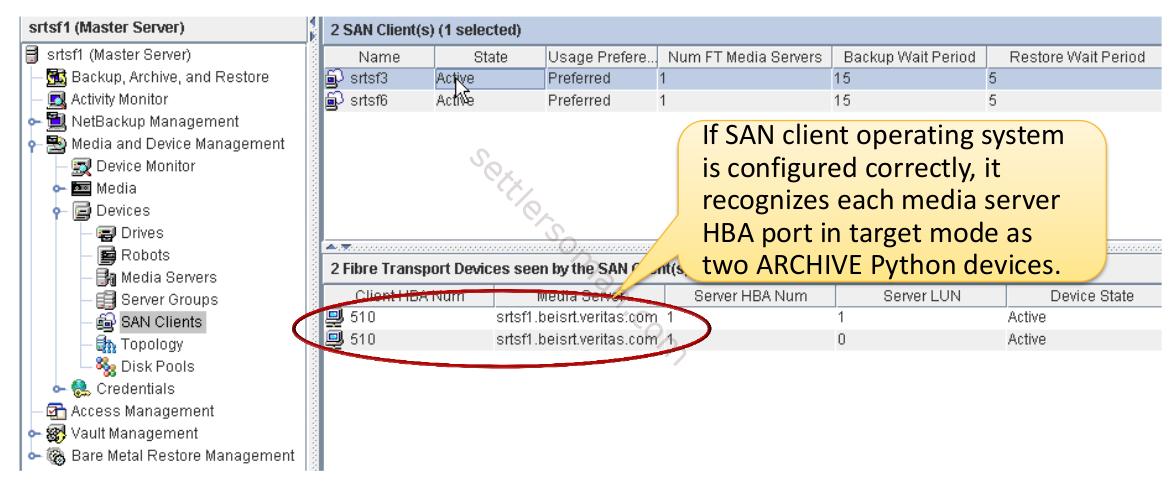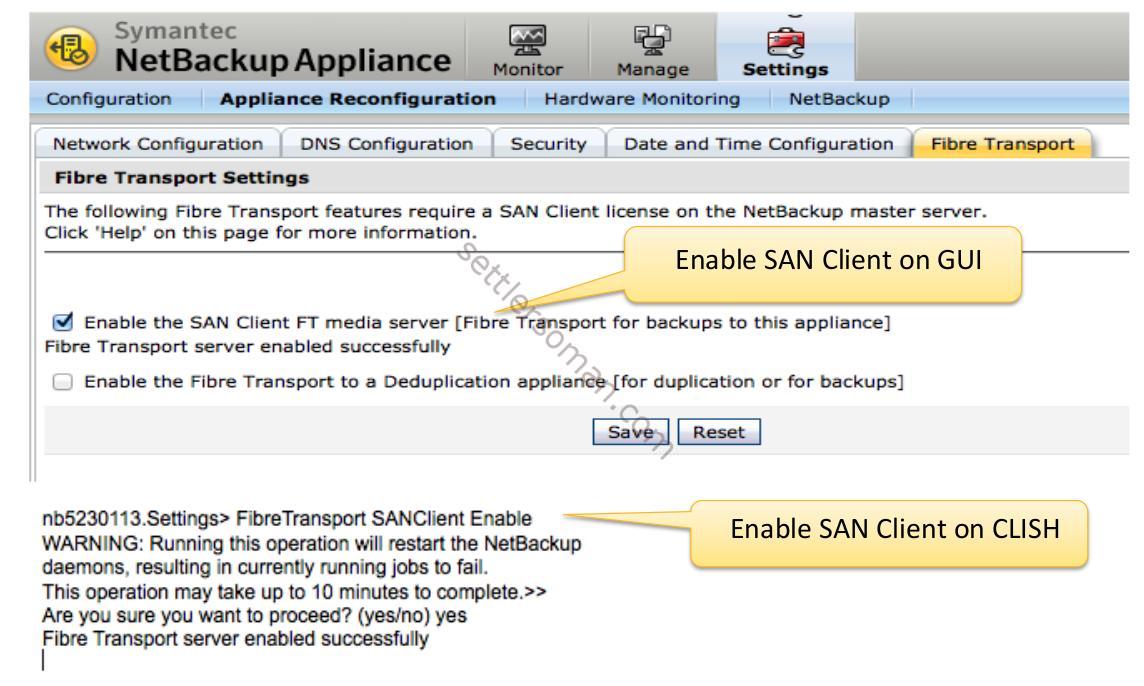In this post I will explain what NetBackup SAN Client is and how to configure it.
A SAN client is a special NetBackup client that can back up large amounts of data rapidly over a SAN rather than a LAN. So when we can use it? The reasons can be as follows:
- LAN backup and restore no longer meets SLAs.
-
High performance data transfer for the client and offloads the LAN (especially environments without 10GBit network) with the backup traffic.
- Replacement of SAN Media Server - NetBackup SAN Client is included in NetBackup Client binaries so it is not necessary to install Media Server binaries only to backup client by SAN.
NetBackup SAN Client terminology
- Fibre Transport (FT) - this is a method of data transfer. It uses Fibre Channel and a subset of the SCSI command protocol for data movement over a SAN rather than TCP/IP over a LAN. FT connections between NetBackup clients and NetBackup servers are referred to as FT pipes.
-
FT Media Server - this is a NetBackup media server on which the Fibre Transport services are activated. FT media server acts as Target of FT pipes.
-
FT Service Manager (FSM) - runs in the same process as EMM. FSM interacts with the FT services that run on SAN clients and on FT media servers. FSM discovers, configures, and monitors FT resources and events.
- Target Mode Driver - replaces the default, initiator mode driver. Target mode applies only to QLogic HBAs.
NetBackup SAN Client requirements
-
NetBackup master server and all NetBackup media servers that use thefeature must be at NetBackup 6.5 or later.
- HBAs and their drivers must support 256K size buffers for data transfer.
-
For the connections to the SAN clients, use a QLogic HBA that NetBackup supports for Fibre Transport. For these HBAs, you must configure them to use the NetBackup target mode driver.
-
Only 64bit Solaris SPARC and Linux x86_64 platforms are supported as Fibre Transport servers.
- PBX service must run on the SAN clients.
-
Enter an Enterprise Client license key on Master server to activate SANClient.
NetBackup SAN Client Configuration on Media Sever
-
Start nbhba mode on the media server by running the following command:
/usr/openv/netbackup/bin/admincmd/nbftsrv_config -nbhba
Example:
/usr/openv/netbackup/bin/admincmd/nbftsrv_config -nbhba
Installing nbhba driver. Are you sure you want to unload QLogic driver: qla2300? [y,n] (y)
/usr/sbin/update_drv-v-d-i "pci1077,2312.1077.12a" qlc
Done copying driver into system directories. Done adding driver.
MUST REBOOT TO COMPLETE INSTALLATION. - Reboot the host.
-
Display the QLogic HBA ports on the media server by using the following command:
/usr/openv/netbackup/bin/admincmd/nbhba -l
Example:
/usr/openv/netbackup/bin/admincmd/nbhba -l
1 2312 21:00:00:E0:8B:83:9D:A1 "QLA2342" 0 0 101
2 2312 21:01:00:E0:8B:A3:9D:A1 "QLA2342" 1 0 101The HBAs are in initiator mode: the second rightmost column shows 0, and the rightmost column does not begin with 8.
-
Mark the ports as targets by using the following command:
/usr/openv/netbackup/bin/admincmd/nbhba -modify -wwn wwn_string -mode target
Example:
/usr/openv/netbackup/bin/admincmd/nbhba -modify -wwn21:00:00:E0:8B:83:9D:A1 -mode target
/usr/openv/netbackup/bin/admincmd/nbhba -modify -wwn 21:01:00:E0:8B:A3:9D:A1 -mode target
-
Run the nbftsrv_config script.
/usr/openv/netbackup/bin/admincmd/nbftsrv_config
Installing the Jungo driver and Fibre Transport Server. The following automatic startup and shutdown scripts (respectively) have been installed. They will cause the NetBackup Fibre Transport Server daemon to be automatically shutdown and restarted each time the system boots.
/etc/rc.d/rc2.d/S21nbftserver
/etc/rc.d/rc3.d/S21nbftserver
/etc/rc.d/rc5.d/S21nbftserver
/etc/rc.d/rc0.d/K03nbftserver
/etc/rc.d/rc1.d/K03nbftserver
/etc/rc.d/rc6.d/K03nbftserver
It may be necessary to temporarily unload your QLogic drivers to free up the ports for the nbhba drivers. This is an optional step. If you choose not to do this, you may not have access to all of the HBA ports until a subsequent reboot. Would you like to uninstall and reinstall your native QLogic drivers now? [y,n] (y) y -
The Qlogic drivers must be unloaded temporarily so that the stub driver (ql2300_stub) can bind to the marked HBA ports during this session. To unload the QLogic driver, answer y.
Are you sure you want to unload QLogic driver: qla2300? [y,n] (y) y
Removing qla2300.
Adding qla2300.
Adding qla2xxx. -
To start the QLogic SANsurfer agent, answer y.
Would you like to start the SANsurfer agent (qlremote)? [y,n] (y) y
Starting qlremote agent service Started SANsurfer agent.
/etc/udev/permissions.d/50-udev.permissions updated with Jungo WinDriver permissions.
NetBackup Fibre Transport Server started. -
To ensure that the FT server always starts after a computer reboot, answer y.
Would you like to make these changes persist after a reboot? [y,n] (y) y
Running mkinitrd.
Previous initrd image is saved at /boot/initrd-3.0.9-11.ELsmp.img.12-21-09.12:37:03.
NetBackup SAN Client Configuration on Clients
- Verify that the Symantec PBX service is active on the client.
-
On the client, run the following command to enable the SAN Client Fibre Transport Service (nbftclnt):UNIX and Linux:
/usr/openv/netbackup/bin/bpclntcmd -sanclient 1
Windows:
install_path\NetBackup\bin\bpclntcmd.exe -sanclient 1
- Reboot Client.

SAN Client - source: Blueprint
NetBackup SAN Client Configuration on Appliances
52x0 Appliances support Fibre Transport. However, this feature requires fibre channel HBAs to be installed in the specific slotes. The SAN client can be enabled via GUI or command line:

SAN Client on Appliances - source Blueprint
Conclusion and useful links
Growing popularity of 10GBit LAN and strict requirements (e.g. Linux Media Servers) cause that SAN Client is less popular than some years ago. However, this is a really good feature to offload the LAN and replace SAN Media Server.
For more information please follow: